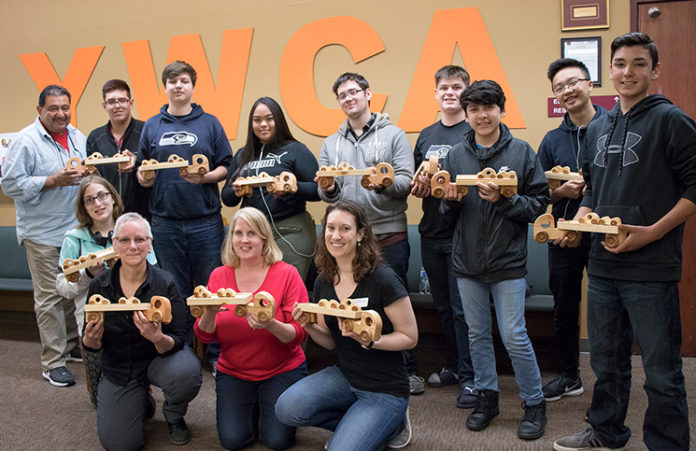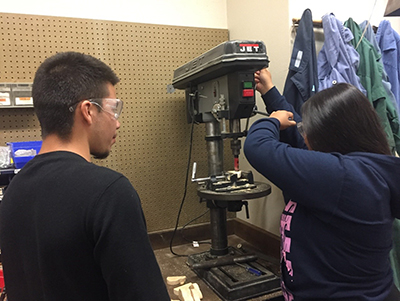
Susan Mangin had an unusual but critical feature in mind when she designed a new manufacturing class for students at Heritage High School – she wanted to engage the students creatively.
So for her “Imagine It, Design It, Make It” (IDM) class, she decided that the students would have to figure out how to create a product design, build a manufacturing line and launch a construction process, mostly on their own. And her students didn’t disappoint, she said. The result? About 40 wooden toy trucks, each holding two cars in the bed, rolled off the class’ production line at the end of the 2017-2018 school year.
“We had a brainstorming session on how to get students more interested in manufacturing ways,” Mangin said. “So, we decided the product would be these toy trucks and cars. I sketched out the truck after looking around online, and we had a class vote on which two cars we wanted to go with it.”
The original class concept was suggested by a local manufacturing company on the school’s Careers and Technical Education (CTE) advisory board. And after the first year’s success, Mangin said the IDM class will become a yearly offering at Heritage High. It was so popular, in fact, that she’s teaching two classes on the subject in the 2018-2019 school year.
“We had a manufacturer on the board for our CTE class, and they said, ‘you don’t have any manufacturing at all, can you do that?,’” Mangin explained. “They asked that we make it different from an engineering class, so we came up with a different approach.”
In a joint statement from Columbia River Economic Development Council (CREDC) Interim President Max Ault and Evergreen School District CTE Director Susan Dixon, the two said that Clark County’s future economy requires a skilled workforce with training in CTE and access to higher education science, technology, engineering and mathematics (STEM) degrees.
“In Evergreen School District, Career and Technical Education (CTE) is focused on Project-Based Learning where students tackle authentic projects or problems,” the statement reads. “Our business and nonprofit partners support student learning by providing authentic projects where students can get hands-on experience and see the business impact of their projects on others – such is the case of the ‘Imagine It, Design It, Make It’ class at Heritage High School.”
“CREDC is committed to fostering partnerships between our region’s businesses, Clark College and local school districts – like Evergreen – to provide opportunities for youth to explore and consider the competitive range of options available to them post high school,” the statement continued.
Mangin, who is the architecture and engineering teacher at Heritage High, worked with John Akers, CTE program manager, to develop the curricula.
Students in the class were instructed that they would be making several copies of an item, and that they needed to organize the production steps and come up with stations for a production line. The students all drew the truck and cars in a design program called Inventor, which is an Autodesk product like AutoCAD.
“Most students had very little wood shop experience, if at all,” Mangin said. “After working with Inventor and converting the designs to AutoCAD, we printed the patterns out on cardboard and made a prototype.”
The students then made several adjustments to the prototype – including extending the truck bed so it could fit the two wooden cars.
“They figured out how much material was needed, figured out a material list and looked up on Home Depot how much we were going to buy,” Mangin said. “Then we did a cost estimate and had to figure out the steps.”
The kids then brainstormed about what stations they needed for the production line and who would work at which station.
“I think that was one of the more valuable lessons they learned,” Mangin said. “It seems easy until you break down the process step by step. And that’s important in just about any project.”
Still, the students answer to the production line surprised Mangin, who thought the students would attack the problem in a much more general manner.

“I was going to rotate the students around, but the kids each migrated to one area or station and they wanted to stay there,” Mangin said. “I had one student who just wanted to drill windows, one just wanted to sand. It was fascinating. I thought they’d get bored with their stations, but they just kept wanting to do them.”
And even though there was a wide variety of stations, none of them went unfilled.
“I had a couple students doing inspections and quality checks,” Mangin said. “I had one girl who liked putting wheels on the cars, and I didn’t realize how hard that was until I tried it and got blisters.”
At the end of the semester, each student got to keep one of their production line trucks. The class also donated about 20 trucks to the YWCA of Clark County, destined for children in the shelter for those fleeing domestic violence.
“It was great to learn that this was possible – I really wasn’t sure if this was something we were going to achieve,” Mangin said. “To do 40 to 50 pieces, wow. I think the students are very capable. They had a goal and they were able to reach it. They were determined to hit the goal and get them all done – and they hit the deadline.”
Mangin also had a special request for local area construction companies: If you have any 2×4 or 2×6 lumber left over after a project, she’d love to get a donation so that her students can have more materials to work with. Anyone interested can contact her at susan.mangin@evergreenps.org.



